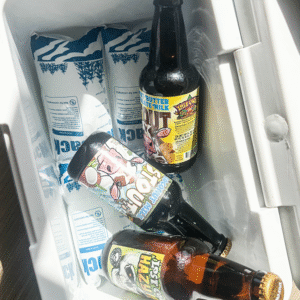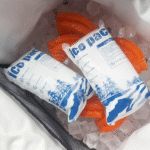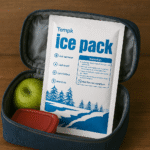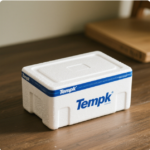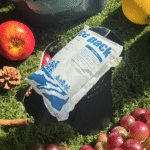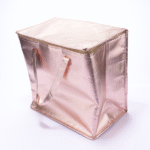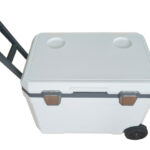Cómo empacar hielo seco en un refrigerador de forma segura (2025)
Si necesita resultados congelados -sólidos, aprendiendo Cómo empacar hielo seco en un refrigerador the right way is essential. Pre -chill, bloques de envoltura, Agregar una barrera, empacar fuerte, and vent safely. Do that and you’ll keep food frozen 24–72 hours, comply with the 2.5 kg airline limit, and avoid cracked lids or soggy messes. This guide merges and upgrades three drafts you provided into one 2025‑ready article.
-
How to pack dry ice in a cooler for 24–72 hours with a simple, repeatable method
-
¿Cuánto hielo seco necesitas realmente? by cooler size and trip length
-
How to pack dry ice in a cooler for flights under the 2.5 kg rule
-
How to pack dry ice in a cooler without freezing drinks using barriers and layout options
-
que comprar (bloques vs pellets) and how to avoid rapid loss and food burn
How to pack dry ice in a cooler for 24–72 hours?
Respuesta corta: Preenfriar la hielera, wrap dry ice blocks, add a cardboard/divider barrier, pack items tightly, y mantén el paquete ventilado. Coloque el hielo seco arriba for the longest frozen hold (Fregaderos de aire frío); ponlo under a barrier at the bottom if you want items chilled, no congelado. Gloves and eye protection are non‑negotiable.
Por qué funciona para ti: Dry ice is –109 °F (–78,5°C) y se convierte directamente en gas (no melt water). Wrapping reduces surface loss, barriers protect liners and food, and tight packing cuts warm air pockets that “eat” your dry ice. A pre‑chilled cooler plus wrapped blocks can stretch performance from 24 up to ~72 hours depending on size, clima, y aberturas de tapa.
Layouts that simplify how to pack dry ice in a cooler
Top -back (max hold): Items → cardboard barrier → wrapped dry ice blocks → close lid
Paquete de fondo (easy access): Barrera → wrapped dry ice → barrier → items
Paquete lateral (dos zonas): Divider with dry ice on one side; drinks/produce on the other
| Layout Option | Mejor para | Vigilancias | Lo que significa para ti |
|---|---|---|---|
| Top -back | Longest frozen hold | Slightly less convenient access | Use for meat, pez, ice cream on multi‑day trips |
| Paquete de fondo | Mixed “just cold” loads | Retención por congelación más corta | Keeps snacks accessible; add water‑ice above barrier |
| Paquete lateral | Split frozen/chilled | Needs a divider | Protects fillets while keeping drinks unfrozen |
Practical tips that save pounds of dry ice
-
Pre -chill: Load with sacrificial ice overnight; dump it before packing dry ice.
-
Envoltura & barrera: Newspaper/kraft wrap every block + corrugated sheet to protect liners.
-
Llenar huecos: Towels or frozen bottles remove air pockets and slow sublimation.
-
Sombra & shut: Mantener alejado del sol; open the lid fast and rarely.
Caso del mundo real: A 55 qt hard cooler, pre‑chilled overnight with a cardboard barrier and a 10 lb top‑pack block, kept ice cream solid for ~36 hours at 88–92 °F with minimal openings.
How to pack dry ice in a cooler: how much do you need?
Regla general: 5–10 lb por 24h in a well‑insulated hard cooler. Scale up for larger coolers, calor alto, frequent access, or flight altitude effects. Many field users plan ~10 lb per 15″ of interior length for deep‑freeze targets over 24–48 h.
estimador rápido (use it in 30 artículos de segunda clase)
-
Duración del viaje (días): D
-
Cooler class multiplier: Small = 1, Medium = 1.5, Large = 2, XL = 3
-
Base rate: 7.5 libras/24h (midpoint of 5–10 lb)
-
Ajustes: +25% hot sun; +10% frequent access
Fórmula: Pounds = D × 7.5 × Class × (1 + Adjustments)
Ejemplo: 48 H, Medio, hot sun (+25%), frequent access (+10%) → 2 × 7.5 × 1.5 × 1.35 ≈ 30 lb.
tabla de tallas (frozen target)
| Tamaño más frío | 24 H | 48 H | Para ti |
|---|---|---|---|
| Pequeño (20–35 cuartos) | 5–10 lb | 10–20 lb | Overnight frozen snacks/meat |
| Medio (45–65 cuartos) | 10–15 lb | 20–30lb | Campamento de fin de semana; keep game/fish solid |
| Grande (75–110 cuartos) | 15–25 lb | 30–40 lb | Multi‑day hunts or outages |
| SG (150 qt+) | 25–40 lb | 50–80 lb | Extended runs; verify compatibility |
Estimates assume a hard, dry‑ice‑compatible cooler and tight packing.
How to pack dry ice in a cooler for flights (2025)?
Respuesta directa: ≤2.5 kg (5.5 lb) por pasajero/paquete, envasado ventilado, and “Dry Ice/Carbon Dioxide, solid” marking with net weight. Seek airline approval before travel. Never tape the cooler airtight. Use gel packs to protect items when the dry ice is gone.
Checklist that passes acceptance:
-
Hard cooler that respiraderos (gasket/drain cracked per maker guidance)
-
Etiqueta: "Hielo seco" (o “Dióxido de carbono, sólido") + masa neta (p.ej., “2.5 kg or less”)
-
Aprobación: Confirm with your carrier before check‑in
-
Layers: Bloques de envoltura + barrera + paquete apretado; minimal air space
-
Carry/Check: Orient to vent; avoid sealed trunks during ground legs
How to pack dry ice in a cooler without freezing drinks?
Barrera + colocación + separation. Keep drinks on one side with water‑ice; put wrapped dry ice behind a divider o on top with a barrier over fragile items. That gives you cold sodas without “freezer‑burn” spots on produce or cheese.
Bloque vs pellet: what should you buy?
-
Bloques: Más larga bodega; fewer gaps; best for 48–72 h goals
-
Pellets/Pepitas: Faster pulldown; llenar los vacíos; great as a top‑up around blocks
-
“Airline cuts”: Pre‑sized packs to hit ≤ 2.5 kg when flying
Always wrap and add a barrier either way.
Hielo seco vs. paquetes de gel vs. hielo regular (what’s right for you?)
| Método | Temperatura típica | Lasts About* | Lo que significa para ti |
|---|---|---|---|
| hielo seco | –78,5°C (–109°F) | ~18–24 h per 5–10 lb | True frozen hold; no melt water; requires PPE & desfogue |
| paquetes de gel | ≈ –18 °C to 0 °C | 12–24h (size/insulation dependent) | Manejo más seguro; reutilizable; great for 2–8 °C |
| Hielo regular | 0 ° C (32 ° F) | 4–18h | Barato, fácil; adds water weight and mess |
*Your results vary with insulation, sun, y con qué frecuencia abres la tapa.
User‑friendly safety rules you can’t skip
-
Nunca es hermético: Gas buildup can bulge lids or rupture containers.
-
Ventilate vehicles and rooms: CO₂ is invisible and can displace oxygen; crack windows and avoid sealed trunks.
-
Use guantes aislados y protección para los ojos: Prevent frostbite and contact injuries.
-
Dispose in open air: Let leftover dry ice sublimate in a ventilated area—never in sinks or sealed trash.
2025 developments that change how to pack dry ice in a cooler
Qué hay de nuevo: Transportadores reutilizables, PCM (materiales de cambio de fase) para carriles de 2 a 8 °C, y Registradores de temperatura IoT now complement dry ice. Teams mix Paneles VIP + PCM to shrink dry‑ice mass, cut waste, and monitor in real time. CO₂ supply dynamics still affect regional availability, so plan purchases ahead in peak seasons.
Último de un vistazo
-
Reusable systems rising: Less EPS waste, lower long‑term cost
-
Monitoreo inteligente: App‑connected loggers flag temperature drift early
-
personaje + PCM combos: Smaller packs, temperatura más estable, menos excursiones
Insight del mercado: Expect steady growth in cold‑chain packaging and monitoring through the late 2020s. Para ti, that means more options to combine dry ice with PCMs and loggers for greener, safer trips.
Preguntas frecuentes
¿Cuánto dura el hielo seco en un refrigerador??
In a good hard cooler, plan 5–10 lb for ~24 h. Heat and frequent openings shorten that; pre‑chill and tight packing extend it.
Where should dry ice go—top or bottom?
Top for frozen results (fregaderos fríos). Bottom under a barrier if you just want “cold, not frozen.”
Can I fly with dry ice in my cooler?
Sí-≤2.5 kg (5.5 lb) por pasajero/paquete, ventilado, etiquetado, and approved by the airline.
Will dry ice crack my cooler?
Use a dry‑ice‑rated hard cooler and add a barrera. Many soft coolers are no rated.
¿Es seguro el hielo seco en un coche??
Yes with ventilación. Crack windows and avoid sealed cabins during long legs.
Actionable tools
2‑minute “Do I need dry ice?” self‑check
-
Goal frozen solid ≥24 h? En caso afirmativo, Use hielo seco; if no, use PCMs/gel packs.
-
Open lid ≥1×/hr? Agregar +10% hielo seco.
-
Hot sun > 90 ° F? Agregar +25% dry ice and shade the cooler.
-
Carga mixta? Side‑pack with a divider; bebidas + water‑ice on the warm side.
Copy‑and‑use packing checklist (print for your lid)
-
Verify cooler is dry‑ice compatible
-
Pre -chill 12–24h
-
Plan libras with the quick estimator
-
Bloques de envoltura + agregar barrera
-
Empacar bien; fill all air gaps
-
Respiradero (crack drain/lid per maker)
-
Monitorear temperaturas (≤ 40 °F for food; ≤ 0 °F for frozen items)
-
Desechar de forma segura al aire libre
Acerca de Tempk
We help teams move temperature‑sensitive goods safely and simply. Nuestros cargadores reutilizables, Paquetes de PCM, and connected loggers are validated to cut excursions and speed pack‑outs. Informe de clientes fewer repacks y retiene más tiempo with our standard kits. Talk to us about a dry ice or PCM setup for your lanes—we’ll turn this guide into your SOP.






